“Putting the wreath he wove from many-leavedivies on his curly blond hair, Lysios, Artemis’s son…”From the Caunos Protogenes Exedra Inscriptions
Holy Trees of the Gods and Goddesses
Most of the flora and fauna specimens you will come across when hiking in the Köycegiz-Dalyan Special Natural Reserve 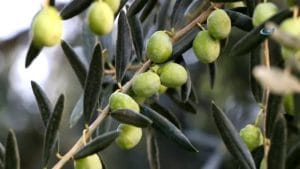 hold some very old secrets that they will whisper into the ears of those who wish to know and understand. Some plants were used medicinal in ancient times and even today by those who are practitioners of alternative medicine. Some of this plant life provides delicious food and spices enjoyed by the locals, while some others warn you that they are poisonous through their shiny colours.
hold some very old secrets that they will whisper into the ears of those who wish to know and understand. Some plants were used medicinal in ancient times and even today by those who are practitioners of alternative medicine. Some of this plant life provides delicious food and spices enjoyed by the locals, while some others warn you that they are poisonous through their shiny colours.
The bay tree, olive tree, cypress and wild ivy, widespread species of the Mediterranean coastal flora, have been subjects of myths, becoming symbols of gods and goddesses. While wandering among the magnificent ruins of what were once monumental buildings in Caunos, you will come across an aged olive tree deeply rote into the theatre’s seats, bay trees shading the Agora with their pleasant aroma and the heart-shaped leaves and white globular flowers of the wild ivy among the bushes. As you meander further and fall into the deep past, recollect those stories conveyed by the ancients in classical mythology and add some more colour to your imaginings as your journey continues.
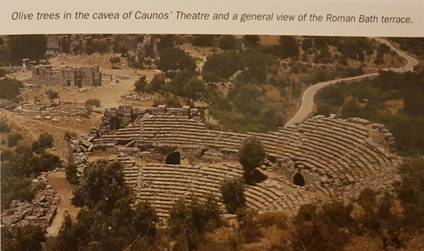
Bay Tree (Daphne): Holy Tree of Apollo, God of Light
Apollo is the God of light and illumination and of sober and rational strength. A leader of the Muses, he is the great god who inspires music, painting, poetry and dance, in short all branches of the arts. Another Apollonian power is to bestow prescience to those who wish to become “mantis” or soothsayers; the diviners of the future.
According to Greek and Roman mythology: “Daphne, daughter of Thessalian river god Paneus, was a beautiful nymph, but would shun men as she had pledged her virginity to earth mother Gaia Apollo fell in love with her and pursued her passionately. Just when he was about to catch and embrace her, however, Daphne begged her father to save her, who in turn transformed her into a bay tree. With the pangs of unrequited love, Apollo assimilated the Bay tree as his own sacred possession. While playing his lyre and directing his chorus of Muses, the god would always wear a wreath made of bay leafs. According to a second myth explaining the connection between the bay tree and Apollo, the Goddess Leto gave birth to her twins Apollo and Artemis clasping a bay tree.
In antiquity, wreaths of laurel were an essential and prized ornament used to distinguish the best artists in variety of competitions. The fact that a majority of the golden crowns excavated from ancient graves were laurel wreaths expresses the importance given to art and rational thought in those days.
Bay Tree (Laulos nobis), it is an aromatic evergreen tree with glossy leaves native to the Mediterranean region, used both in the kitchen and the cosmetic industry.
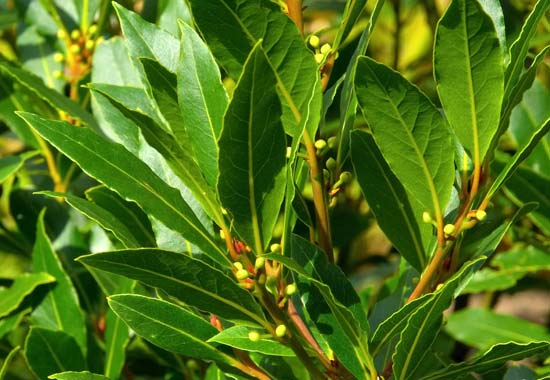
The Olive Tree is Goddess Athena’s Symbol
The bright-eyed virgin goddess Pallas Athena, one of the twelve Olympian gods and goddesses, is the daughter of Zeus, father of the gods and Metis, goddess of reason and wisdom. However, fearing that his yet unborn baby might be wiser than himself, Zeus swallows Mctis together with the child she was carrying and incorporates them into his own body. Leaping out of her father’s head as a young girl clad in armour and helmet and holding a spear, Athena is a fierce warrior who rulcs armies and terrorises enemies. She is, however, also the patroness of wisdom and the crafts.
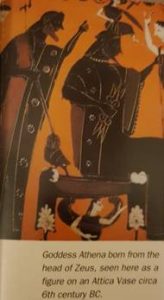 A myth regarding the founding of the city of Athens explains the connection between Athena and the olive tree, which is her sacred tree. A competition was held between Athena and the sea god Poseidon, both of whom wanted to name the city, and the competition was juried by the other Olympian gods Poseidon struck his trident into the rocks of the Acropolis and created a saltwater lake. Athena’s gift, however, was the olive tree, the fruit and oil of which have been used by the peoples of the Mediterranean ever since. In gratitude for this valuable gift, the city was called Athena and the peninsula in which it is located was named Attica. Athena, in whose honour a famous temple was built on the acropolis, was revered as the patron goddess of the city.
A myth regarding the founding of the city of Athens explains the connection between Athena and the olive tree, which is her sacred tree. A competition was held between Athena and the sea god Poseidon, both of whom wanted to name the city, and the competition was juried by the other Olympian gods Poseidon struck his trident into the rocks of the Acropolis and created a saltwater lake. Athena’s gift, however, was the olive tree, the fruit and oil of which have been used by the peoples of the Mediterranean ever since. In gratitude for this valuable gift, the city was called Athena and the peninsula in which it is located was named Attica. Athena, in whose honour a famous temple was built on the acropolis, was revered as the patron goddess of the city.
For this reason the olive tree is one of Athena’s symbols Philosophers and other citizens bestowing the city with their wisdom were traditionally presented with wreaths of olive branches.
Escaping from the passionate embrace of Apollo, Daphne is transformed into a Bay tree.

Wild Ivy Wreaths are the Chief Ornament of the Dionysian Festivities
Dionysius was a nature God of Anatolian origin who was born in the golden plains and wood-covered mountains of Phrygia and entered Greek mythology after the 5th century BC. However, what he symbolises is not nature itself, but the relation man of nature’s secrets. The Dionysian cult presents wine and drunkenness as the easiest way to do this. However, while the between man and nature as well as the magical power that teaches stagy given by wine mobilises the creativity latent in human nature, it also reveals the primitive impulses repressed by social rules. For this reason the rituals held in honour of Dionysus, god eyras and wine, have inspired tragedy, which could be called the most humane of poetic genres.
Maenads who represent the unbridled passion of the feminine, the satyrs embodying the masculine virility and the silken, the companions to Dionysius are all part of the Dionysian cult. In his famous tragedy The Bacchae, Euripides relates how women, the ‘’Bacchae,’’ who leave their homes following Dionysus wore dotted antelope skins in imitation of the maenads, carrying snakes and tambourines, and danced under the influence of drink and religious ecstasy. In many places of his tragedy, Euripides writes of wraths woven of wild ivies and worn on the head as part of Dionysian rituals, and says: “Happy are those who follow Dionysus holding the Thyrsus and wearing the ivy wreath…”, “Wear the ivy wreaths, let their flowers blossom…’’
In Greek urns too, this humble creeper that is easily recognisable growing on fences with its heart-shaped leaves was the chief ornament of Dionysus and the maenads following him, one of the symbols of the wine god. For this reason it was customary in antiquity to place an ivy wreath on the first guest to get very drunk at a drinking bout.
Olive Tree is one of the symbol of Goddess Athena. Olive wreaths were traditionally presented to philosophers and artists of the ancient world.
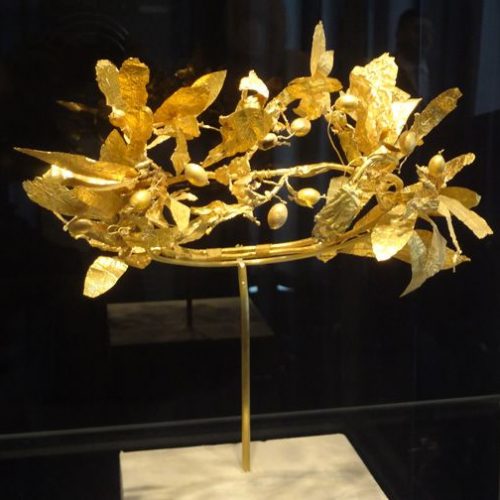
An Attica Vase (circa 6th century BC), showing Dionysus with its chief ornament of heart shaped leaves with two Maenads.
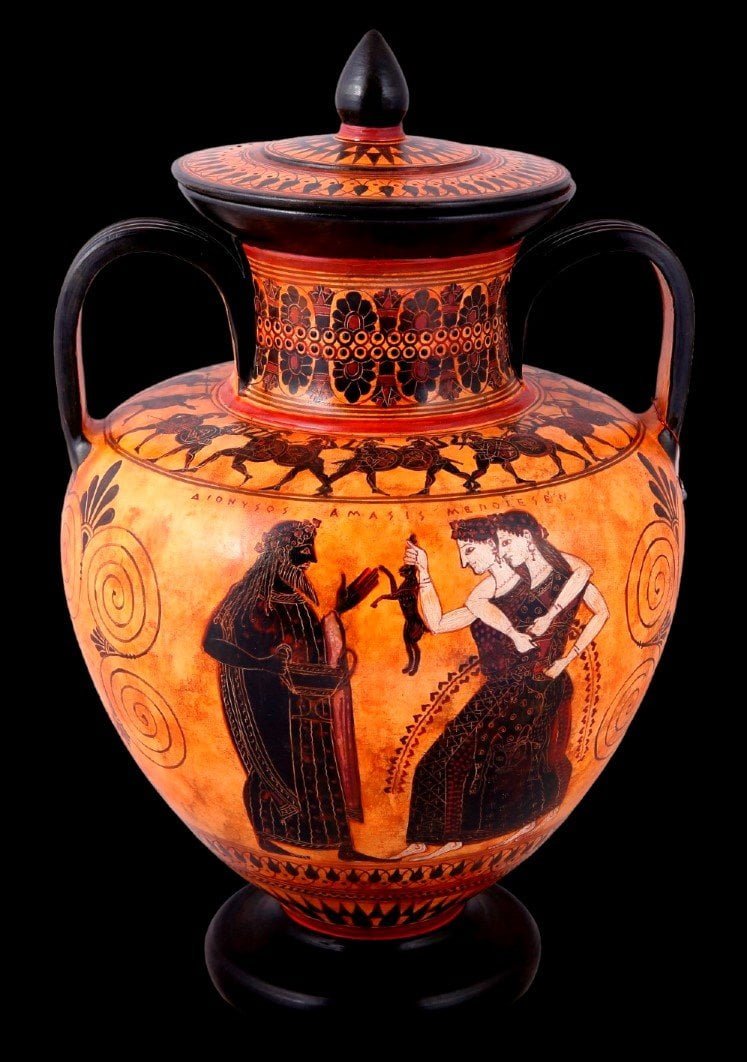
The Tears of the Sweet Gum
The sweet gum (incense) tree does not have a myth of its own, but this pretty and valuable tree is very important as it is an endemic species that has been able to survive for some 60 million years. Pollen research shows that sweet gum forests spread across a wild area covering Japan, Russia, Central Europe and North America in the 3rd geological epoch (Miocene). However, the glaciations beginning in the 4th geological epoch caused a reduction in zones habitable to gum trees as is the case with many other species.
The Sweet Gum trees are able to grow only in temperate regions where the winter temperature is minimum +3 C 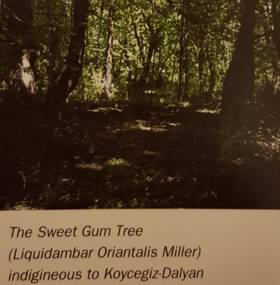 (optimum +6-+10°), the rainfall average is high and underground water is close to the surface. In the arid months of the summer it meets the water that is necessary for its existence from the underground water and small brooks in the vicinity.
(optimum +6-+10°), the rainfall average is high and underground water is close to the surface. In the arid months of the summer it meets the water that is necessary for its existence from the underground water and small brooks in the vicinity.
The deciduous sweet gum, which is of the Hamamelidaceae family is an imposing tree with a maximum height of 25 metres and a large crown.’ Its narrow leaves with long stems have 3-5 and sometimes seven lobes, have sharp teeth. There are four kinds of sweet gum, which are found in regions approximately in the same latitude of the northern hemisphere with similar climactic conditions (China, Taiwan, North America and Southwest Anatolia in intermittent forest Populations.
The largest population of the Anatolian sweet gum (Liquidambar Orientalis) is found in the south-western coastline of the Mugla province in Marmaris, Köycegiz, Fethiye and Dalaman. Traveling from Köycegiz to Ortaca or from Ortaca to Dalyan, you can stop by one of the sweet gum groves at the side of the road and take a close look of this great tree that has been in existence for 60 million years as well as the biological diversity in the wetlands that are its habitat. At the same time hard statistical fact will remind you of a sad truth for which the sweet gum sheds tears. In 1940s, the total sweet gum forests of western Anatolia were 6300 hectares, but in 2008 only 1350 hectares remained with 320 hectares consisting of broken groves (Dostbil, Ketenoglu, Kurt-2008).
The reason for the rapid extermination is the fact that the balsam of the sweet gum, which used to be very valuable in the past, no longer brings a profit. Man’s greed that goes beyond reason and destroys nature has shown itself here too. The surface water is drained using drainage canals around the sweet gum groves and the gum trees, which depend on plenty of water to live, are left to dry out en masse. The only purpose of this massacre is to obtain more farmland.
The sweet gum balsam is a resin that is not contained in the tree under normal conditions, but which the tree secretes in order to repair and protect itself when the trunk is injured. The Latin for the Anatolian gum tree is “Liquidambar Orientalis Miller.” The name is a compound consisting of “Liquidus” (balsam) that expresses the tree’s capability to secrete balsam and the Arabic word ‘amber” due to the pleasant smell of this balsam, which is further defined with the word “Orientalis,” meaning “eastern gum tree.” However, as it has spread only in Anatolia, this species is known rather as the Anatolian gum tree (Dostbil, Ketenoglu, Kurt-2008).
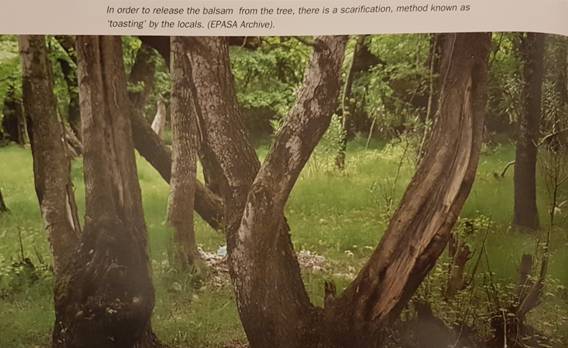 The sweet gum balsam is a product, the obtaining of which requires much effort and is limited to a certain region. As it was considered a very important medication in antiquity and as it was used in embalming in Ancient Egypt, traders took it to all corners of the world. Due to the pleasant aroma provided by the cinnamic acid (cinnamon acid) in its structure, the sweet gum balsam was burnt in festival halls, funerals and religious ceremonies to provide a pleasant atmosphere with its aromatic smoke. The sweet gum oil obtained by distilling the balsam is used as a fixer in perfume production, connecting the scents comprising the perfume’ permanence to the new scent resulting from this combination. However, the production of cheaper synthetic fixers has diminished the demand of sweet gum oil. Popular medicine still uses sweat gum balsam for medicinal purposes. It is applied to the skin as antiseptic and parasiticidal in skin diseases such as mange and fungus. It is also believed to cure respiratory tract diseases such as bronchitis and asthma.
The sweet gum balsam is a product, the obtaining of which requires much effort and is limited to a certain region. As it was considered a very important medication in antiquity and as it was used in embalming in Ancient Egypt, traders took it to all corners of the world. Due to the pleasant aroma provided by the cinnamic acid (cinnamon acid) in its structure, the sweet gum balsam was burnt in festival halls, funerals and religious ceremonies to provide a pleasant atmosphere with its aromatic smoke. The sweet gum oil obtained by distilling the balsam is used as a fixer in perfume production, connecting the scents comprising the perfume’ permanence to the new scent resulting from this combination. However, the production of cheaper synthetic fixers has diminished the demand of sweet gum oil. Popular medicine still uses sweat gum balsam for medicinal purposes. It is applied to the skin as antiseptic and parasiticidal in skin diseases such as mange and fungus. It is also believed to cure respiratory tract diseases such as bronchitis and asthma.
Using the sweet gum balsam as medication is a logical solution. The reason for this is that it is a natural chemical compound used by the tree prate to itself against parasites, insects and bacteria by covering its scars. The process for obtaining the balsam and converting it into sweet gum oil through distillation starts with thinning the tree bark towards the end of March, a process which is called “toasting” by the locals. The “toasted” portions are scraped using a tool called a “spoon” and scars called “veins” are opened entering slightly into the wood. During the period starting at the middle of July and ending at the end of October, the balsam, bark, cambium and wood layer on the scars is scraped in chips once every fortnight. In the region this process is called “sur alma” while the sweet gum chips obtained are called “kapçık.” In order to extract the thick oil they contain, the kapçık are boiled in copper cauldrons and pressed. The oil is purified through the last process which is distillation.
Doing this without harming the tree requires knowledge, experience and skills that were obtained over the centuries. The fact that sweet gum oil can no longer be marketed at the value it deserves is another reason for its extinction, along with the destruction of the sweet gum woods. There are now only a few elderly people who know the technique of obtaining balsam from sweet gum trees. The partnership of man and the sweet gum tree will come to an end if they die without raising new generations.
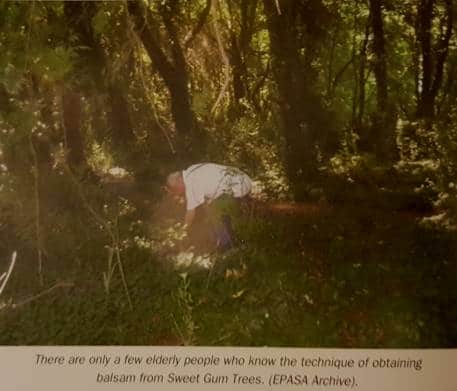
Source: Koycegiz – Dalyan A Journey Through History Within The Labyrinth of Nature, (pages: 93-100), Altan Türe, 2011, Faya Kültürel Yayınları

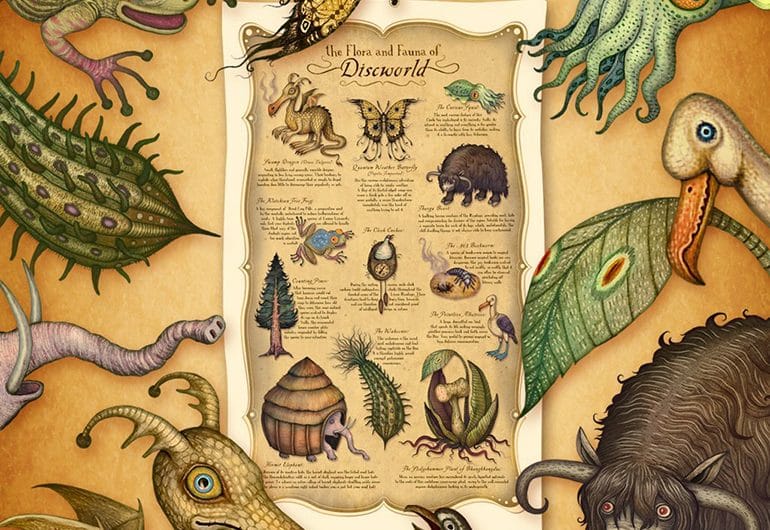
Comments